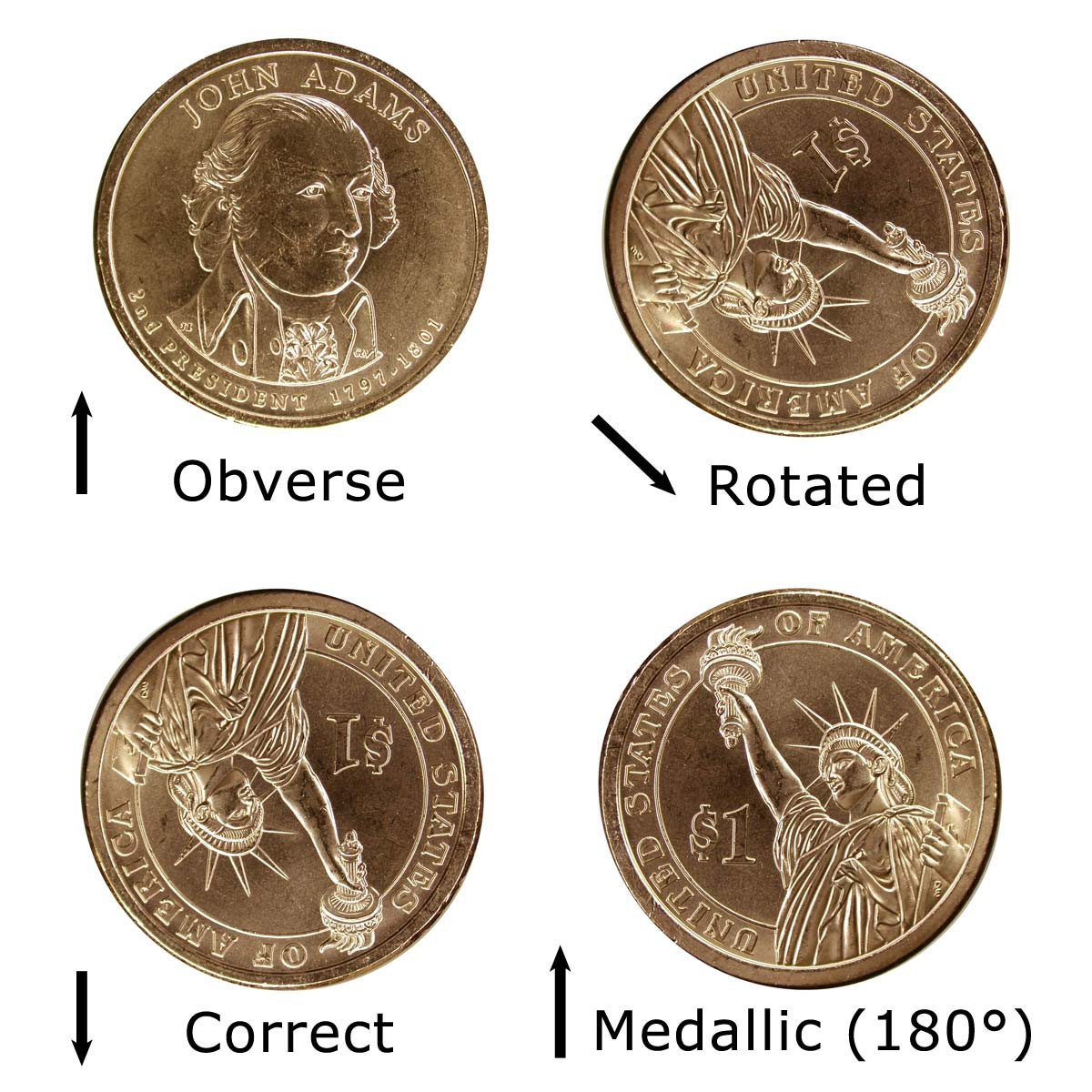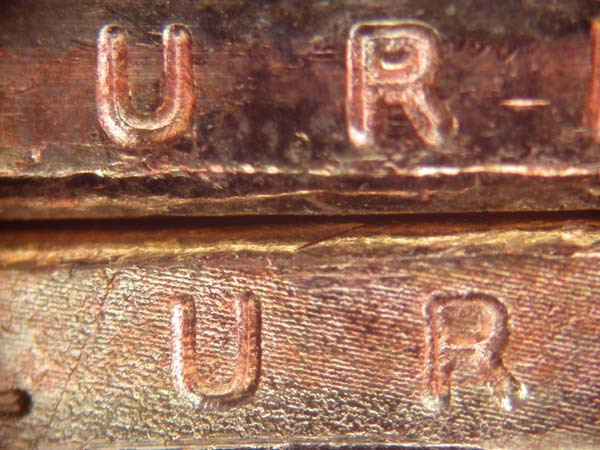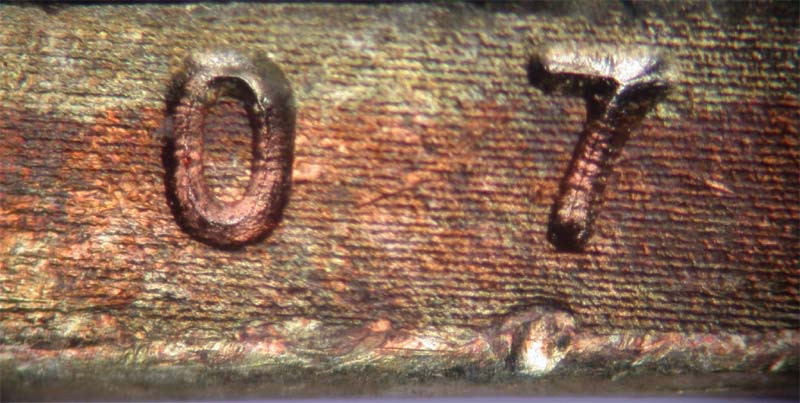The John Adams $1 coin, part of the US Presidential Dollar series, has become a fascinating subject for coin collectors, largely due to the prevalence of striking errors, especially concerning its edge lettering. Similar to its predecessor, the Washington $1 coin, the John Adams dollar is rife with edge lettering anomalies that have captured the attention of numismatists and error coin enthusiasts. Among the earliest recognized errors for this coin issue are doubled edge letterings, a striking mistake that occurs when a coin mistakenly passes through the edge lettering machine twice during the minting process.
Doubled Edge Lettering Errors
Doubled edge lettering is a prominent category of errors found on the John Adams dollar coin. This error arises when a single coin is processed through the edge lettering machine on two separate occasions. There are two primary forms of this doubled error, both meticulously documented and recognized by the Numismatic Guaranty Corporation (NGC), a leading coin grading service.
Overlapped Lettering
Overlapped lettering occurs when the second pass through the edge lettering machine imprints the coin’s edge such that the new set of letters partially or entirely overlaps the first. The degree of overlap can vary significantly, creating a spectrum of error variations. Due to space limitations on NGC certification labels, this specific error is abbreviated as DBL.EDG.LET. – OVERLAPPED.
Inverted Lettering
Inverted lettering, another type of doubled edge lettering error, is more distinct. In these instances, the second set of letters is not just overlapped but also inverted relative to the first. This means the two sets of edge lettering are oriented in opposite directions. If you hold the coin with the obverse (front) side facing upwards, one set of letters will read correctly, while the other will appear upside down. NGC designates this error on its certification labels as DBL.EDG.LET. – INVERTED.
Since the John Adams dollar coins are fed into the edge lettering machinery in a random orientation, the placement and orientation of the edge lettering, as well as any doubling, are also inherently random. This explains the diverse presentations of doubled edge lettering, ranging from closely overlapped to widely separated and inverted.
 Obverse of 2007 P John Adams coin with exploded edge view showing overlapped doubled edge lettering, alongside a close-up of the overlapped lettering.
Obverse of 2007 P John Adams coin with exploded edge view showing overlapped doubled edge lettering, alongside a close-up of the overlapped lettering.
 Obverse of 2007 P John Adams coin with exploded edge view showing inverted doubled edge lettering, next to a close-up of the inverted doubled edge lettering on the coin's edge.
Obverse of 2007 P John Adams coin with exploded edge view showing inverted doubled edge lettering, next to a close-up of the inverted doubled edge lettering on the coin's edge.
Missing Edge Lettering Errors
Another notable error observed in the John Adams dollar series is the complete absence of edge lettering. This error occurs when a coin bypasses the edge lettering process altogether, resulting in a blank edge. Such coins, devoid of the intended inscriptions, are certified by NGC as having MISSING EDGE LETTERING, marking them as significant mint errors.
 Obverse of a (2007) John Adams coin with an exploded edge view, displayed with a close-up of the blank coin edge, illustrating the missing edge lettering error.
Obverse of a (2007) John Adams coin with an exploded edge view, displayed with a close-up of the blank coin edge, illustrating the missing edge lettering error.
Die Errors
Beyond edge lettering errors, the John Adams dollar coins also exhibit errors stemming from the dies used in the striking process. These die errors are common across various modern coin types and include issues like filled dies and rotated dies.
Struck Thru Errors
Filled die errors happen when foreign material such as dirt, grease, or metallic debris adheres to the die surface during the minting process. When a coin is struck with a die that has a filled area, that portion of the die fails to impart its design detail onto the coin. These errors are cataloged as OBV STRUCK THRU, indicating that the error is on the obverse (front) of the coin and resulted from being struck through debris.
Rotated Die Errors
Rotated die errors arise when a die rotates within the coinage press during striking or is improperly installed initially. These rotations can be minor, falling within the mint’s tolerance levels, or major, representing a significant deviation from the intended die alignment. Interestingly, John Adams dollars have been found with a wider range of rotation degrees compared to the Washington dollars, where only one primary rotation variation has been prominently observed to date.
In some John Adams dollar coins, the die rotation is so pronounced that it results in “medallic” alignment instead of the correct “coin” alignment. Medallic alignment is specifically defined as a 180-degree rotation of the dies. NGC recognizes and designates rotated die errors when the rotation is 15 degrees or greater.
 Image of a John Adams coin obverse exhibiting a struck-through error due to grease, dirt, or metal particles filling the dies, causing design loss, alongside an illustration of rotated die errors demonstrating various rotation types.
Image of a John Adams coin obverse exhibiting a struck-through error due to grease, dirt, or metal particles filling the dies, causing design loss, alongside an illustration of rotated die errors demonstrating various rotation types.
The Matte Edge Mystery
A more recently discovered and unusual error in the John Adams dollar series is the “matte” edge. Coins exhibiting this error have an edge that appears frosted or matte-like, in contrast to the standard shiny edge. Initially, this difference might be subtle, requiring closer inspection with magnification to discern. Upon magnification, the edge reveals fine lines consistent with laser etching, suggesting this matte finish might be inadvertently caused by the edge lettering die being laser-etched. Currently, NGC is still investigating this matte edge John Adams $1 coin to determine its attribution and official recognition as a distinct error type.
 Comparison view of a "matte" edge (bottom) against a normal edge (top) on John Adams dollar coins, highlighting the difference in texture and finish.
Comparison view of a "matte" edge (bottom) against a normal edge (top) on John Adams dollar coins, highlighting the difference in texture and finish.
 Close-up view of the date portion on a John Adams dollar coin's "matte" edge, showing parallel lines indicative of laser etching, suggesting the cause of the matte finish.
Close-up view of the date portion on a John Adams dollar coin's "matte" edge, showing parallel lines indicative of laser etching, suggesting the cause of the matte finish.
Collectors and enthusiasts are encouraged to stay informed about ongoing discoveries and updates regarding the John Adams dollar and other coins in this series as NGC continues its research.
Interested in the value of your John Adams $1 coin? Explore the NGC Price Guide for detailed coin values.
Learn more about dollar coin errors by reading about $1 Error Coins.
You might also be interested in exploring content from our affiliated companies, such as this guide to the most expensive Pokémon cards in the world.
